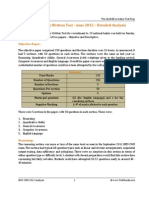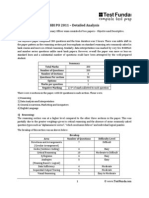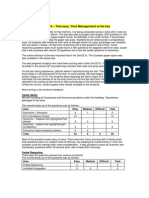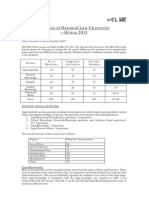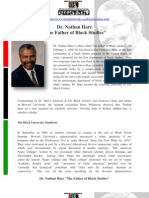Ibps Analysis
Ibps Analysis
Uploaded by
suresh1852Copyright:
Available Formats
Ibps Analysis
Ibps Analysis
Uploaded by
suresh1852Copyright
Available Formats
Share this document
Did you find this document useful?
Is this content inappropriate?
Copyright:
Available Formats
Ibps Analysis
Ibps Analysis
Uploaded by
suresh1852Copyright:
Available Formats
Analysis of the 2nd IBPS CWE for POs/MTs (Held on 17th June 2012 First Shift)
The 2nd IBPS CWE for PO/MT which was held on 17th June2012 floored the candidates. The exam was a tough nut to crack. Barring the English Section, the rest of the test areas had quite a few difficult questions, the reasoning section being the most difficult, closely followed by the quant section. One can say with out any second thought that this paper was the toughest of the bank exams conducted in the last couple of years. The duration of the objective paper was 150 minutes and this was immediately followed by a Descriptive Test of 1 hour duration. To help you understand the IBPS Bank PO CWE paper better, we provide you with a comprehensive analysis below. First, let us look at the snapshot of the exam.
Snap Shot Of Bank PO CWE Exam Number Of Objective Questions 250 Test Areas Maximum Marks(Objective) Negative Marking Duration Of Objective Test Number Of Descriptive Questions Maximum Marks(Descriptive) Duration Of Descriptive Test Total Duration Of Exam 5 225 0.25 150 minutes 3 25 60 minutes 31/2 Hours
Now let us take a look at the detailed analysis of the different test areas. The different test areas from which the questions were asked in the exam were Reasoning, Quantitative Aptitude, General Awareness, Computer Awareness and English Language. There were 50 questions, all objective type, from each of these 5 test areas. Analysis of the Objective Test : (1) Quantitative Aptitude
There were 10 questions based on simplifications and approximations. About half of these questions were easy and the other half were time consuming. There were 5 questions on series. The questions involved finding the wrong number in the given sequence. These questions were diffficult. Coming to the individual questions, there were 15 questions, as against the 10 questions in the first IBPS CWE for PO conducted in Sep2011. These questions involved a good mixture of concepts and logic from various topics like Simple Equations, Ratio, Percentages, Simple
Interest-Compound Interest, Permutations & Combinations, Probabulity, Time &Work, Mensuration. As regards Data Interpretation, there were 4 sets of 5 questions each.As compared to the previous IBPS PO exam, the DI part of the paper was difficult. Overall, in terms of difficulty level, this section can be considered to be moderate to difficult and an attempt of 30 32 questions, with not more than 2-3 wrong is considered to be very good. The best approach would have been to answer series and the individual questions first and then solve the DI sets, answering only the easier ones in the DI sets. The following table gives the topic wise break up of the questions asked in this section. Topic wise break up of topics Quantitative Aptitude Topic No of Questions Simplifications Approximations Series(Finding the wrong number) Individual Questions: Simple Equations Ratio, Proportion Percentages Profit & Loss Simple & Compound Interest Permutation & Combination Probability Time & Work Mensuration Data Interpretation: Pie Chart + Table Bar Graph + Table Line Graph + Table Caselet Total 5 5 5 5 50 5 5 5
5 3 1 1 1 1 1 1 1
(2) English Language
The English section of the paper was more or less similar to the English section of the exam held in Sep 2011. There were 50 questions and the break up is as follows: Vocabulary : 10 Qs on Cloze passage (as against 15 Qs in Sep 2011). The passage was on climate change, fairly simple and the blanks were mostly on the appropriate usage of verbs. Easy to Moderate. 5 Qs on FIB (same as in Sep 2011) There were 5 Qs on fill in the blank. Each sentence had one blank with six possible words given for the blank. The student had to select the option that showed the two words that could fill the blank without any change in
meaning. 3 easy, 1 moderate, and 1 difficult because of the close choices. Grammar: Unlike Sep 2011 when there were no questions on grammar, this year's paper had 15 Questions on Grammar. Error Identification: There were 10Qs on error identification. Each question had a sentence broken into four parts. The student had to identify the part that had an error. 8 Qs easy and 2 Qs moderate. Error Correction: There were 5Qs on error correction. Each question had a sentence with part of it in bold. Different ways of phrasing the underlined part was given and the student has to select the one that is grammatically correct. The questions were easy. Both these question types have appeared in the Bank PO exams earlier. Para Forming Question: The passage had 6 sentences which were jumbled up. The examinee had to rearrange the sentences to form a paragraph and then answer the 5Qs based on it. It was moderately difficult but easier than the one in Sep 2011. Reading Comprehension: There was one passage of moderate difficulty with 15 questions. The passage was about 900 words and there were 8 comprehension questions and 7 vocabulary questions (4 synonyms and 3 antonym). In Sep 2011, there had been 2 passages of about 700 words with 8 and 7 questions on them including 2 questions on vocabulary. Of the 8 comprehension Qs, 5 were detail based and 3 were inferential, all were moderately difficult. 5 of the vocab Qs were easy and 3 moderately difficult. Overall the paper was easier than the one in Sep 2011 and the main difference was the return of questions on grammar.
(3) Reasoning
The reasoning section of the paper was toughest of all the test areas. The topic wise break up of the questions is given below. Topic wise break up of topics Reasoning Number of Topic questions Deductions 7 Critical reasoning(All individual 6 questions) Distribution + Linear Arrangement 8 (1 set) Circular Arrangement + Blood 7 Relations (1 set) Comparisons (1 set) 3 Input/Output Data Sufficiency (Reasoning based) Non- Verbal (Series) Total 4 5 10 50
This section was a real shocker !! The only saving grace in this section was the the questions on Deductions, Input -Output and one set on puzzles about 14 questions. The rest of the questions were tough and time consuming. And talking about the set on circular aarrangements, the students would have got lost in the set and that too with out any final out put. In general, the questions on data sufficiency are easy to crack in the bank exams, but in this exam these questions were also difficult. A new type of question set was also seen in the section of non verbal reasoning. A score of 20 22 is a very good score in this section.
(4) Computer Knowledge
The questions on Computers were difficult when compared to the ones given in the first IBPS CWE for PO. Questions asked were from a wide range of sub-topics of Computers and were not on the expected lines. An average student would have found this section tough. Students with specialisation in computer subjects definitely would have had an advantage over others. Questions from topics like OS comcepts, Word processing, Spread sheets, Powerpoint were not direct questions, as one expects them to be in bank exams. About 1/3rd of the questions were based on internet terminology, which included questions on URL, E-mail, Web terminology etc. Topic wise break up of topics Computer Awareness Topic No. of questions Acronyms Terminology Introductiont to concepts of Computer Basic Computer Architecture Memory Data representation Software Concepts Operating Systems DBMS Computer Networks Internet E-Commerce MS Office: WORD MS Office: EXCEL MS Office: POWERPOINT Total 1 1 1 1 9 2 7 15 4 4 5 50
Over all, this section was difficult with questions being asked from a much wider range of topics / terminology and this required a lot of thinking and analysis.In general, this section is always a high scoring one, but in this exam a high score in this section will be a remote dream for the aspirants.
(5) General Awareness
The classification of questions from this section is given below. Topic Banking Awareness Indian Economy Current Affairs - National Current Affairs - International Sports Literature Films Awards Science & Technology Total No. of questions 22 8 5 5 4 1 1 1 2 50
Of the 22 questions on Banking, 4 were difficult, 9 were moderately difficult and 9 were easy. The banking questions were mostly conceptual/hypothetical, rather than statistics based. The questions on Indian Economy was relatively easier. The questions on curent affairs were easy and this was the saving grace for the students and they would have scored well in these questions. In the miscellaneous group, the four questions related to Sports were easy. Films & Awards had one questions each and were also easy, whereas the two questions from Science & Technology, and one from Literature (books & authors) were difficult. Overall, the paper can be described as difficult. A well prepared, focussed student will be able to score in the range of 26 28.
Analysis of the Descriptive Test : The Descriptive Writing section did not present any surprises.This test was for 50 marks ( to be scaled to 25). The tasks that were asked were as follows. Letter Writing: The students were asked to write a letter of 150 words from the given three topics. Two of these were formal letters and one was an informal letter. Marks alloted for this task was 15.
Letter to your younger brother/sister explaining the significance of conducting the census - every 10 years. Letter to an appropriate authority bringing to their attention lack of adequate educational facilities in your area. Letter to a local news paper highlighting the significant contrubution of one common citizen in influencing actions / developments in your area.
Essay Writing: An essay of 250 words , from the three given topics. The topics were on social and economic aspects.Marks alloted for this task was 20. Growth of Banking sector in India Role of big business houses towards green initiatives Role of micro finance companies in social and economic development.
Precis Writing: A precis in 130 words of a passage of about 375 words. 15 marks was alloted for this task. Those who had spent some time on regular practice would have been able to perform well in this section.
Over all, this paper will be a low scoring one !!
You might also like
- Complete CELPIP Preparation Guide: A Detailed Overview of the CELPIP: IELTS Confidence, #2From EverandComplete CELPIP Preparation Guide: A Detailed Overview of the CELPIP: IELTS Confidence, #2No ratings yet
- Emcee ScriptDocument4 pagesEmcee ScriptSanthe Sekar100% (2)
- Educational System of Selected Countries of The WorldDocument6 pagesEducational System of Selected Countries of The WorldBA RT78% (46)
- Ibps Cwe (Po) June2012 AnalysisDocument0 pagesIbps Cwe (Po) June2012 Analysisbhavk20No ratings yet
- Bank PO-CWE Analysis 2011: Test PrepDocument5 pagesBank PO-CWE Analysis 2011: Test PrepSharad SrivastavaNo ratings yet
- Ibps Po Cwe 2014 AnalysisDocument2 pagesIbps Po Cwe 2014 AnalysisKarthick SureshNo ratings yet
- Maharashtra CET - 2012 AnalysisDocument5 pagesMaharashtra CET - 2012 AnalysisHabib KhanNo ratings yet
- Bank SBI Main Exam 2011 AnalysisDocument3 pagesBank SBI Main Exam 2011 AnalysisSourabh SharmaNo ratings yet
- IBPS PO CWE Mains 2015 AnalysisDocument2 pagesIBPS PO CWE Mains 2015 AnalysisAditya MishraNo ratings yet
- SBI PO - June 15, 2014 - Exam Analysis & Expected Cut-OffDocument3 pagesSBI PO - June 15, 2014 - Exam Analysis & Expected Cut-OffbalarajuNo ratings yet
- CET 2010 AnalysisDocument5 pagesCET 2010 AnalysisVinay RaikarNo ratings yet
- Feedback On CET 2014 - First Day First Slot AnalysisDocument3 pagesFeedback On CET 2014 - First Day First Slot AnalysisSameer PandeyNo ratings yet
- SNAP 2012 Analysis: 1. Logical Reasoning - 30 QuestionsDocument3 pagesSNAP 2012 Analysis: 1. Logical Reasoning - 30 QuestionsAchyutPareekNo ratings yet
- IBPS - Clerical - CWE - Mains - 2015 AnalysisDocument5 pagesIBPS - Clerical - CWE - Mains - 2015 Analysisganeshji loNo ratings yet
- Analysis of IITTM 2010 (18 April 2010) : Sr. No. Topic No. of Questions Difficulty Level 1Document2 pagesAnalysis of IITTM 2010 (18 April 2010) : Sr. No. Topic No. of Questions Difficulty Level 1naggarwal_10No ratings yet
- Analysis: SNAP 2012: Overview of Different SectionsDocument2 pagesAnalysis: SNAP 2012: Overview of Different SectionsKaranwadhwaNo ratings yet
- Pgcet PatternDocument5 pagesPgcet PatternVivekananda MgNo ratings yet
- UPSC Prelims 2013 Analysis: Paper I - GSDocument0 pagesUPSC Prelims 2013 Analysis: Paper I - GSrajputrulesNo ratings yet
- NABARD 15 Pre-Exam AnalysisDocument4 pagesNABARD 15 Pre-Exam AnalysisAshwani RanaNo ratings yet
- Analysis of Last Two YearsDocument3 pagesAnalysis of Last Two YearsRekha ShakyaNo ratings yet
- Analysis of National Law University - Orissa 2011Document4 pagesAnalysis of National Law University - Orissa 2011Pranjal KalantriNo ratings yet
- The Writing Test of IeltsDocument27 pagesThe Writing Test of IeltsHa nguyen100% (1)
- IBSAT 2010 Analysis by ZION EducationDocument2 pagesIBSAT 2010 Analysis by ZION EducationMbatutesNo ratings yet
- Cael Ce An OverviewDocument46 pagesCael Ce An OverviewgeronimofgNo ratings yet
- Tiss 2Document3 pagesTiss 2grlinblujeansNo ratings yet
- Chi 1Document7 pagesChi 1onyamenaayestreetNo ratings yet
- Revised AFF Test Material by Saboor and Sagheer 1.2Document60 pagesRevised AFF Test Material by Saboor and Sagheer 1.2abdullahas0308No ratings yet
- CMAT Sep 2014 Analysis: 1. Quantitative Techniques and Data InterpretationDocument2 pagesCMAT Sep 2014 Analysis: 1. Quantitative Techniques and Data InterpretationHitisha agrawalNo ratings yet
- #1. Exam Pattern For SBI PO 2017 PrelimsDocument8 pages#1. Exam Pattern For SBI PO 2017 PrelimsSri Krishna KumarNo ratings yet
- LEARNINGDocument5 pagesLEARNINGsales zfNo ratings yet
- Ielts Writing Lesson 2 - Bar ChartDocument4 pagesIelts Writing Lesson 2 - Bar ChartBaka WateverNo ratings yet
- Revised AFF Test Material By Saboor and Sagheer 1.3Document78 pagesRevised AFF Test Material By Saboor and Sagheer 1.3muhamikram816No ratings yet
- IIFT - 2014 Analysis & Key-TIMEDocument2 pagesIIFT - 2014 Analysis & Key-TIMElucifer1711No ratings yet
- Cbse Class 10 Term 1 Sample Papers 2013Document8 pagesCbse Class 10 Term 1 Sample Papers 2013c5q8g5tzNo ratings yet
- G.K General Knowledge 21 April 2013 Paper Analysis: Topic Sub Topics No. of QuestionsDocument8 pagesG.K General Knowledge 21 April 2013 Paper Analysis: Topic Sub Topics No. of QuestionsKumar SahilNo ratings yet
- Listening Comprehension of TOEFL: SubjectsDocument32 pagesListening Comprehension of TOEFL: SubjectsMeilani AstyNo ratings yet
- Ilets ExamDocument11 pagesIlets ExamКурілова ОльгаNo ratings yet
- IES Written TestDocument3 pagesIES Written TestShane RodriguezNo ratings yet
- Foreign Language Indonesian: Paper 0545/02 Reading and Directed Writing Key PointsDocument9 pagesForeign Language Indonesian: Paper 0545/02 Reading and Directed Writing Key PointsBrytistaNo ratings yet
- SNAP 2013 AnalysisDocument3 pagesSNAP 2013 AnalysisAchyutPareekNo ratings yet
- (Studyplan) IBPS CWE PO/MT: English, Grammar, Comprehension, Sentence ArragenmentDocument13 pages(Studyplan) IBPS CWE PO/MT: English, Grammar, Comprehension, Sentence ArragenmentSanjeev ChaudharyNo ratings yet
- Tips For Cracking Mah CETDocument8 pagesTips For Cracking Mah CETSiddharth ManuNo ratings yet
- (Topicwise Analysis) Aptitude Paper II of CSAT 2011 MrunalDocument13 pages(Topicwise Analysis) Aptitude Paper II of CSAT 2011 Mrunalsumit dixitNo ratings yet
- 4 09Document6 pages4 09Катя ВасилишинаNo ratings yet
- TOEFL Structure and Written ExpressionDocument24 pagesTOEFL Structure and Written ExpressionSofia Balbontin DoradorNo ratings yet
- Ielts WritingDocument9 pagesIelts WritingdavidramosmoralesNo ratings yet
- PETfs Exam Report March 2010Document27 pagesPETfs Exam Report March 2010Siouxsie SixxNo ratings yet
- A Complete Guide To IELTS Writing: by David S. Wills 2018 Kindle EditionDocument6 pagesA Complete Guide To IELTS Writing: by David S. Wills 2018 Kindle EditionChandra ErickNo ratings yet
- Muet Essay Writing Test GuideDocument5 pagesMuet Essay Writing Test GuideYatt ZainiNo ratings yet
- JSU EnglishDocument5 pagesJSU EnglishNurizyan Norman80% (5)
- Lecture 1Document10 pagesLecture 1Jaykant KumarNo ratings yet
- I 2024 Structure and Written Expression Pertemuan IDocument15 pagesI 2024 Structure and Written Expression Pertemuan Iwardah faza amaliaNo ratings yet
- Infosys Company Profile:, Infosys Exam Cracking KITDocument9 pagesInfosys Company Profile:, Infosys Exam Cracking KITmecitfuturedreamsNo ratings yet
- Detailed SBI PO Syllabus and Guide Prelims 2017Document12 pagesDetailed SBI PO Syllabus and Guide Prelims 2017Sindeesh DineshNo ratings yet
- 2021-2022 Spring-C-Midterm Exam GuidelinesDocument6 pages2021-2022 Spring-C-Midterm Exam GuidelinesSaratobiNo ratings yet
- IELTS Lesson OneDocument10 pagesIELTS Lesson OneRenée ReimiNo ratings yet
- IELTS WritingDocument14 pagesIELTS Writingalexandra.stan9824100% (1)
- (Get Ready For IELTS Writing 4-5.5Document135 pages(Get Ready For IELTS Writing 4-5.5TriếtMinhNo ratings yet
- Constructing Objective Test Items:Simple Form: EDP 3501 Testing and Assessment in EducationDocument46 pagesConstructing Objective Test Items:Simple Form: EDP 3501 Testing and Assessment in EducationCik FarahNo ratings yet
- Reading and ComprehensionDocument16 pagesReading and Comprehensionmungovo prosperNo ratings yet
- IELTS Academic Writing Module: Models for High Band ScoresFrom EverandIELTS Academic Writing Module: Models for High Band ScoresRating: 4 out of 5 stars4/5 (13)
- Spelling Bee 2023 InglésDocument2 pagesSpelling Bee 2023 InglésAbrahan Netzahualcoyotl MendozaNo ratings yet
- Managment Development Process and L&D Evaluation EssayDocument15 pagesManagment Development Process and L&D Evaluation EssayFekry MuafaNo ratings yet
- Cat Logical Reasoning QuestionDocument2 pagesCat Logical Reasoning QuestionAchal Kumar100% (1)
- Cot DLPDocument5 pagesCot DLPJM GalvezNo ratings yet
- Entrepreneurship in The Cultural and Creative IndustriesDocument16 pagesEntrepreneurship in The Cultural and Creative IndustriesJeffJeffNo ratings yet
- General Methods of TeachingDocument4 pagesGeneral Methods of TeachingEmerson Fernandez100% (8)
- The Teaching GapDocument39 pagesThe Teaching Gappsymah100% (1)
- Implementing Task-Based Language Teaching in Korean ClassroomsDocument20 pagesImplementing Task-Based Language Teaching in Korean ClassroomsmamacutitNo ratings yet
- CCC Oral Expression Esl Syllabus Fa09Document6 pagesCCC Oral Expression Esl Syllabus Fa09api-326289552No ratings yet
- Cutting and TailoringDocument90 pagesCutting and Tailoringhamba_dahNo ratings yet
- Reflection (TRNTCRTH Cot2)Document1 pageReflection (TRNTCRTH Cot2)JULIETA DIWATANo ratings yet
- E7 Exploring Passive Solar Energy and Our ClassroomDocument4 pagesE7 Exploring Passive Solar Energy and Our Classroomapi-249625870No ratings yet
- Lesson Guide With Reflection: Mathematics 8 Grade 8 First Modular October 19 - 23, 2020Document2 pagesLesson Guide With Reflection: Mathematics 8 Grade 8 First Modular October 19 - 23, 2020Nhel ParanaNo ratings yet
- Educational ManagementDocument13 pagesEducational ManagementZviad MiminoshviliNo ratings yet
- ThesisDocument152 pagesThesisSusan AsNo ratings yet
- Course-Syllabus TemplateDocument5 pagesCourse-Syllabus TemplateRenz Marron IslaNo ratings yet
- AdhdDocument10 pagesAdhdCallum BromleyNo ratings yet
- House Hearing, 107TH Congress - "Leave No Child Behind"Document60 pagesHouse Hearing, 107TH Congress - "Leave No Child Behind"Scribd Government DocsNo ratings yet
- DR Nathan Hare The Father of Black StudiesDocument11 pagesDR Nathan Hare The Father of Black Studieshostcares9100% (1)
- Lesson Plan Template 3 0Document8 pagesLesson Plan Template 3 0api-380584926No ratings yet
- Effectiveness of Responsive Teaching With Children With Down SyndromeDocument12 pagesEffectiveness of Responsive Teaching With Children With Down SyndromeAudrey NatashaNo ratings yet
- Olivarez College: Dr. Eduardo V. LopezDocument2 pagesOlivarez College: Dr. Eduardo V. LopezRochelle Ann CabralNo ratings yet
- Transferees TipDocument2 pagesTransferees TipJhemmilyn RiveraNo ratings yet
- G10 DLL Week3 2023 2024Document4 pagesG10 DLL Week3 2023 2024EVANGELINE GINGONo ratings yet
- Reflective EssayDocument3 pagesReflective Essayapi-285715277No ratings yet
- Argument Social Media and NarcissismDocument5 pagesArgument Social Media and NarcissismbriegondaNo ratings yet
- Closing in On Close ReadingDocument7 pagesClosing in On Close ReadingElmehdi MayouNo ratings yet
- Chapter-V v.1Document5 pagesChapter-V v.1Marjon P. MaxilumNo ratings yet




